#Greco-Egyptian art
Text

Ancient Egyptian mummy portrait (encaustic on wood) of a boy identified by an inscription as Eutyches. Artist unknown; 2nd cent. CE (Roman period). Now in the Metropolitan Museum of Art.
#classics#tagamemnon#art#art history#ancient art#Egypt#Ancient Egypt#Egyptian art#Ancient Egyptian art#Greco-Egyptian#Greco-Egyptian art#Roman Egypt#Roman Empire#portrait#portrait painting#mummy portrait#children in art#Metropolitan Museum of Art#encaustic#encaustic on wood
553 notes
·
View notes
Text

Hermanubis is a syncretic god combining Anubis and Hermes who was popular during the Roman period of Egypt's history, as both were known for their skills as psychopomps. I was inspired by Byzantine icons for this one. Prints available here.
178 notes
·
View notes
Text



~ Female Head.
Culture: Graeco-Egyptian
Place of origin: Akhmim, Egypt
Date: 1st century B.C.-A.D. 1st century
Period: Ptolemaic Period-Roman Period
Medium: Limestone, stone, pigment
#ancient#ancient art#history#museum#archeology#ancient egypt#ancient sculpture#roman#ancient history#archaeology#Greco-Roman#female head#portrait#akhmim#Egyptian#egyptology#Egypt#ptolemaic#roman period#1st century B.C.#a.d. 1st century
281 notes
·
View notes
Text
Greco-Egyptian art and culture in Italy: the Nile Mosaic of Palestrina
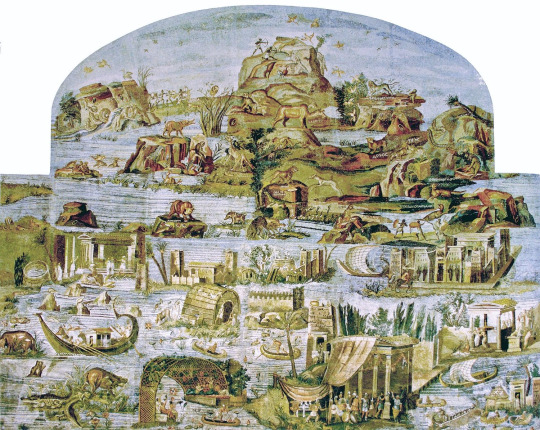
“AMONG ITS EXTRAORDINARY COLLECTION OF regional archaeology, the National Archeological Museum in Palestrina preserves a magnificent piece that stands apart from the rest: an ancient mosaic depicting a vivid scene of the flooding river Nile.
Dating to the 1st century BCE, this Egyptian mosaic is believed to be the product of Alexandrian craftsmen, and it is among the most spectacular of the late Hellenistic age. Measuring almost 20 by 13 feet (6 by 4 meters), the mosaic depicts a flooded Nilotic landscape, inhabited by animals both real and imaginary, Ptolemaic Greeks, Aethiopian hunters, and priests performing rituals in their magnificent temples. The figures are often labeled in Greek characters and the entire scene may represent a vivid map of the Nile as it flows from the highlands of Ethiopia to the delta in the Mediterranean Sea.
Archaeologists expect the mosaic was originally used as a flooring decoration for an apse in a large rectangular room built as an artificial grotto (as can be surmised from the shape of the mosaic), by the forum of the city of Praeneste. The piece has also been identified as evidence of the early spread of Egyptian cults in Italy, especially the cult of the Goddess Isis. (Certain scholars claim that Isis was already at this point being identified with Fortuna, Goddess of Praeneste.)
The mosaic’s rediscovery and preservation have been tumultuous: In the 1600s, the Barberini family removed the mosaic and took it to Rome. It was then returned to Palestrina but damaged in the process and had to be restored anew. During the Second World War, to avoid damage from the allied bombings, the mosaic was once more removed, but it is now again on display in Palestrina.
Know Before You Go
The Nile mosaic is on display on the third floor of the museum, which is open every day from 9 a.m. to 8 p.m.”
Source of the text: https://www.atlasobscura.com/places/nile-mosaic-of-palestrina
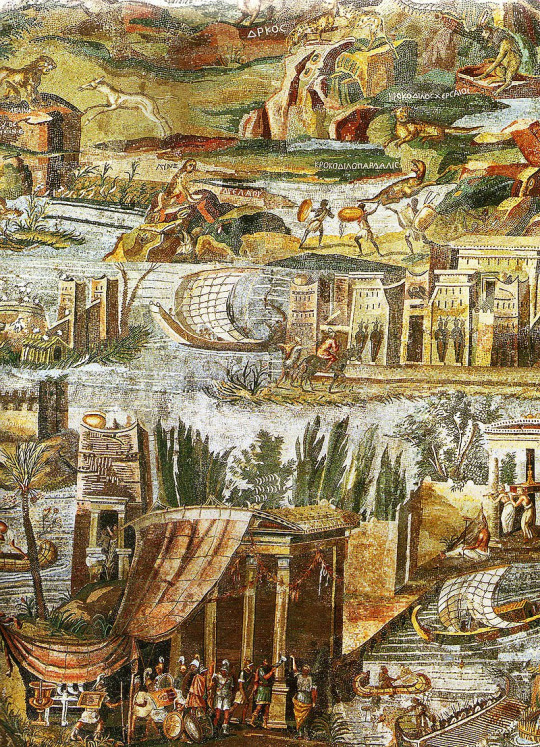

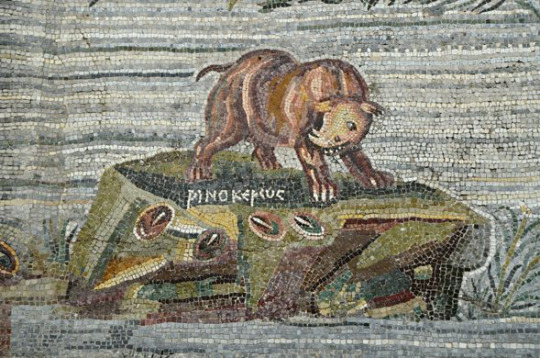
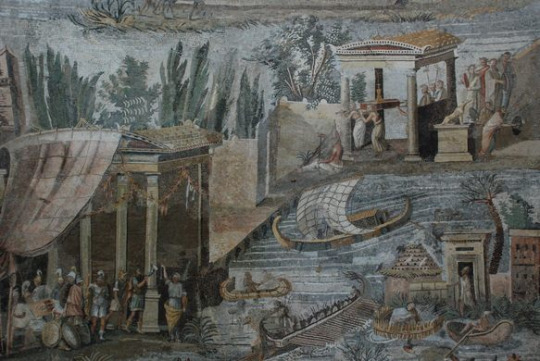


22 notes
·
View notes
Text
Funny how they keep saying that Cleopatra wasn’t “black” or swarthy, yet I keep finding depictions of her from the 1300’s in illuminated manuscripts, as well as in 1800’s 🎨 from France and Italy (done by Europeans!) as exactly that.
This stuff only became a debate after the invention of things like Social Darwinism, i.e. Scientific Racism, which perpetuated the pseudo-scientific idea that all darker-skinned people are a lesser species that evolved from the Troglodyte niger (Chimpanzees).
They don't teach us that a majority of European countries underwent "ethnic cleansing" leading up to WWII, hence the reason why these places look the way that they look today. Back then the Mediterranean, while under Islamic rule for roughly 900 years, was known as the Orient or Western Asia. So-called Greeks and Italians weren’t even considered “white” (at least by American standards) until the 1950’s.
Also, some of these so-called “Egyptians” think we’re all just stupid. They think that we’re not aware that the Egyptian Media has been a catalyst for the ongoing racism against the indigenous Nubians who were living in the country before the Arab invasion. They're totally fine when you're being portrayed in any type of slave role, but god forbid you be put in a sovereign position of authority...
We don’t need Hollywood to “represent or include us”, nor tell us our history. Let these delusional, indoctrinated goofballs be mad 🤣🤷🏾♂️ Oderint, dum metuant!

#ancient egypt#kemet#ta-meri#nubia#mizraim#hellenistic period#ptolemy#ptolemaic dynasty#ptolemaic egypt#greco egyptian#cleopatra vii#mediterranean#whitewashing#blackwashing#history#swarthy#art#cognitive dissonance#selective outrage
16 notes
·
View notes
Text
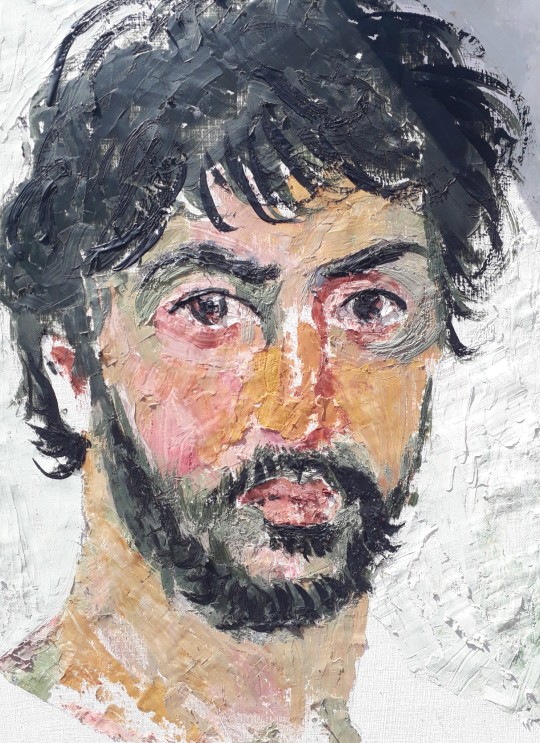
Wip encaustic fayum replica
#my art#encausticpainting#fayum portraits#experimental archeology#re-enactment#living history#beeswax painting#traditional art#greco egyptian#roman art
19 notes
·
View notes
Text
"Let's make games and media about other mythologies and pantheons other than Norse or Greco-Roman" is a take I really, really get, but the unfortunate reality is that most Western media conglomerates are pretty culturally white, and can you imagine the appropriation shitshow that would result from them portraying indigenous mythologies instead of the two pantheons that people can at least somewhat ascribe to Western European tradition? Ancient Egyptian seems the next most "safe" due to cultural penetration and time remove, and even that sparks discourse when it's done. Honestly I'm surprised that Disney even mostly got away with Moana, and that hardly went without critique. I think the execs that don't want bad press are well aware of this and are afraid to wade in.
I mean the obvious answer is for them to just hire people who can boast more claim to the tradition in question, but unfortunately it doesn't tend to work that way en masse, and also, even if they did do that, there would be a continent who would complain anyway. Own narratives are frequently called out as bad rep, usually by people who don't know the provenance (but sometimes even when they do!), and it'd be even worse with a big corporate name from the west attached.
Anyway buy foreign art I guess, but under current trends the big multi-billion God of War equivalent about African tradition is unlikely to come soon, I guess. Kind of an unfortunate side effect of the representation and appropriation discourse that makes certain kinds of narrative more scarce.
(A possible exception to all this might be, for instance, Japanese spiritual tradition, as there are plenty of Japanese media products that do well in the West. But this proves the point, because for instance I can think of examples of video games and films that feature oni, etc, whereas I can't for the less widespread or internationally exposed traditions that I describe).
77 notes
·
View notes
Text

Plant Symbolisms 🌱🌿🪴
Flora have a special corner in literature.
Starting from the Greco-Roman period when certain plants were representative of gods (like olive trees for Athena), plants have meant more than just a source of food or pleasure.
Lotus - Symbol of creation, rebirth, and the sun. The blue lotus represents spiritual enlightenment, while the white lotus symbolizes purity.
Papyrus - Represents prosperity, growth, and regeneration, often associated with the Nile River and the goddess Isis.
Mandrake - Associated with love, fertility, and aphrodisiac properties.
Poppy - Symbol of sleep, healing, and regeneration, often associated with the god of sleep, Hypnos.
Rose - Represents love, beauty, and the goddess Aphrodite.
Jasmine - Symbol of sensuality, love, and spiritual growth.
Palm - Represents victory, triumph, and eternal life, often associated with the god Osiris.
Acacia - Symbolizes resurrection and the afterlife, linked to the god Osiris and the Tree of Life.
Cornflower - Represents fertility, abundance, and regeneration.
Anemone - Symbol of protection, healing, and renewal.
Anemone, garden: Forsaken.
Almond, flowering: Hope.
Balm: Sympathy.
Bamboo: The emblem of Buddha. The seven-knotted bamboo denotes the seven degrees of initiation and invocation in Buddhism.
Bay leaf: I change but in death.
Bell flower, white: Gratitude.
Bluebell: Constancy.
Broken flower: A life terminated, mortality.
Buttercup: Cheerfulness.
Calla lily: Symbolises marriage.
Campanula: Gratitude.
Carnation, red: Beauty always new
Chrysanthemum: I love.
Clover, white: Think of me.
Clover, four-leaved: Be mine.
Cinquefoil: maternal affection, beloved daughter.
Convolvulus, major: Extinguished hopes or eternal sleep.
Coreopsis, Arkansa: Love at first sight.
Crocus: Youthful gladness.
Cuckoo Pint: Ardour.
Cypress tree: Designates hope.
Daffodil: Death of youth, desire, art, grace, beauty, deep regard.
Daisy: Innocence of child, Jesus the Infant, youth, the Son righteousness, gentleness, purity of thought.
Daisy, garden: I share your sentiment.
Dead leaves: Sadness, melancholy.
Dogwood: Christianity, divine sacrifice, triumph of eternal life, resurrection.
Fern: Sincerity, sorrow.
Figs, Pineapples: Prosperity, eternal life.
Fleur-de-lis: Flame, passion, ardour, mother.
Flower: frailty of life.
Forget-me-not: Remembrance / true love.
Furze or Gorse: Enduring affection.
Grapes: represent Christ.
Grapes and leaves: Christian faith.
Harebell: Grief.
Hawthorn: Hope, merriness, springtime.
Heartsease or Pansy: I am always thinking of you.
Holly: Foresight.
Honeysuckle: Bonds of love, generosity and devoted affection.
Honesty: Sincerity.
Ivy: Memory, immortality, friendship, fidelity, faithfulness, undying affection, eternal life, marriage.
Jonquil: “I hope for a return of affection.”
Lalla: Beauty, marriage.
Laurel leaves: Special achievement, distinction, success, triumph.
Marigold: Grief or despair.
Morning glory: Resurrection, mourning, youth, farewell, brevity of life, departure, mortality.
Mystic rose: Mother.
*some of these flower symbols have Greek or Roman origins but were also used in ancient Egyptian culture.
If you like my blog, buy me a coffee☕ and find me on instagram! 📸
🖱️References
https://www.proflowers.com/blog/plant-symbolism-guide
https://www.pinterest.com/pin/396668679699365428/
https://lilysflorist.com/blog/the-symbolism-of-flowers-in-literature-and-poetry-a-look-at-the-hidden-meanings-of-blooms-in-classic-texts/#:~:text=Rose%20%2D%20Represents%20love%2C%20beauty%2C,and%20the%20Tree%20of%20Life.
#writer#writers#creative writing#writing#writing community#writers of tumblr#creative writers#writing inspiration#writeblr#writing tips#writers corner#writers community#poets and writers#writing advice#writing resources#writers on tumblr#writers and poets#helping writers#writing help#writing tips and tricks#how to write#writing life#let's write#resources for writers#references for writers#writer stuff#on writing#flower symbolism#symbols#flower meanings
140 notes
·
View notes
Note
were there any specific styles/cultures you took inspiration from when designing the telchin clothing styles?
Honestly the tricky answer is: a lot-
Initially, it was very much just like “okay does this shape and colour palette and design look cool? Sick” and just throwing thoughts at a wall.
When it came to defining those broader shapes/colours and adding things like specific cuts, details, patterns, etc, I sort of worked backwards to grab inspirations.
Ulysses initial/main outfit is honestly quite Medieval, European (but notably Norse/Scandinavian in its cut/style), albeit with a ridiculously plunging neckline for some reason lol-
(it was even a bit early on that every time one of the cast drew Ulysses, we’d make his neckline just a little bit sluttier)
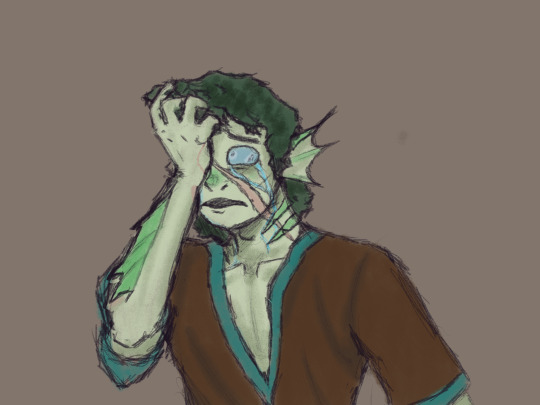

HOWEVER the details on the collar and sleeves are directly lifted from ancient Greco-Roman designs, specifically influenced by the “Greek Key” or “Greek Meander” pattern which can be seen in pottery, jewellery and architecture all over the ancient Mediterranean!

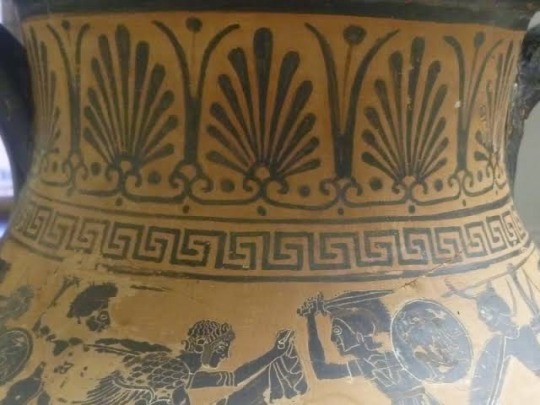
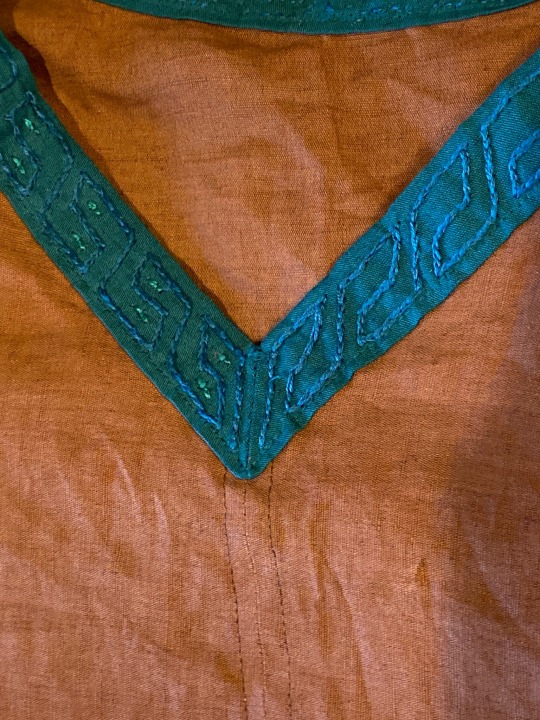
Specific to Ulysses, his clothing has currently reached a fairly fairytale-esque “fantasy” stage, drawing a lot of early Renaissance and pirate-style influences with his little poet-shirt and sash, since he’s been on the Overworld so much, and is slowly growing to become a part of that culture and world, and I really wanted to show that in his clothing changes.
Honestly, a lot of the broader telchin clothing when I have sketched it up is very Greco-Roman, at least in the way I tend to depict it (that is my field of expertise, given my degree haha) but there’s honestly a lot of broader Mediterranean ties in as well. The army and their armour is designed to be very Ancient Macedonian, and a lot of the more casual clothing skew very Ancient Egyptian.
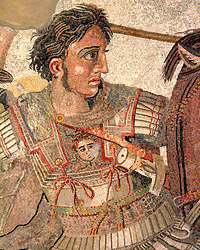

Canonically the Telchin clothing style also definitely develops rapidly over the course of the war with the drowned, mostly for practicality sake more than fashion (loose flowing fabrics aren’t doing anyone much good escaping the undead), leading to an almost 1950s/60s American aesthetic? Of course still mingled with the Greco-Roman patterns. Especially in the way the scientists are presented in lore/my art, they always had a very retro-60’s almost sci-fi scientist aesthetic. If I was to give it a fancy/proper-sounding name I think “Wartime-Americana Retro-Classicism” would be more or less it, potentially lmao-
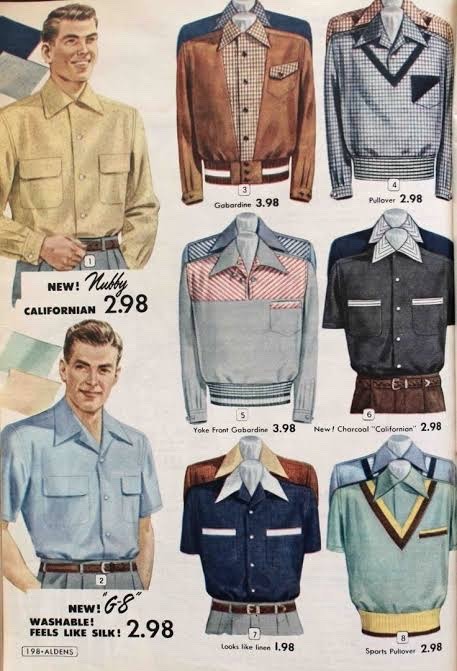
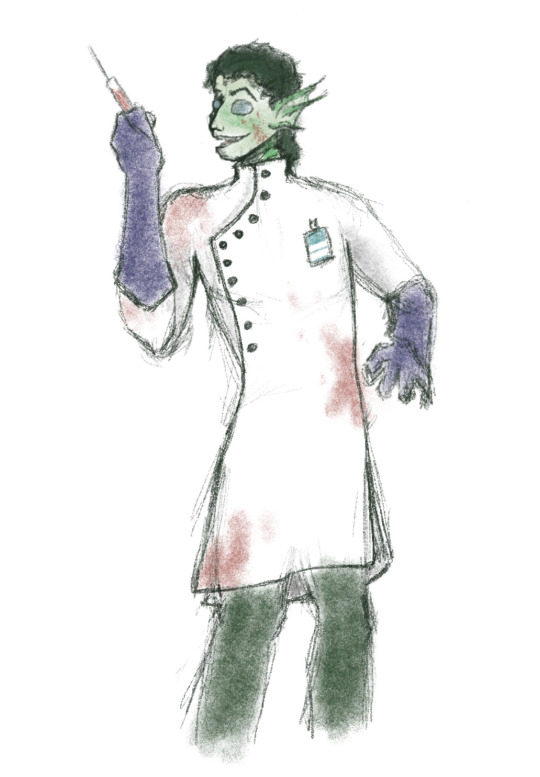

(You can even sort of see similar shapes and patterns in that first reference image to Ulysses eventual design!)
There was of course always a flair of Victorian-Mad-Scientist too, because I have a bit of a brand and I can’t help myself. And given the blurring of science, alchemy and magic in Fable I think it definitely fits.
It’s a shame Tumblr only lets me upload 10 images per post on mobile because I have A BUNCH of reference images for all of these stages of the Ulysses/broader telchin clothing design lol, but sadly I can’t include them here :(
But I hope this was somewhat useful/interesting!! I’ve had so much fun coming up with this kind of stuff over the course of Fable s3 for the telchin and I’m very grateful to Ocie and Metta for kind of just letting me go ham on a bunch of aspects like this lol-
57 notes
·
View notes
Text
Ice is the only hard thing
Steven Grant x Reader
Summary:-
You and Steven go ice skating and accidentally stimulate Steven, but let's be honest, it wouldn't take much to turn that sweetheart on. This is part of @moonknight-events Bingo. There is no description of the reader and no use of y/n.
I used Google translate for the French words
Quelle surprise - I'm surprised
Oui mon amor- yes my love
Salope- bitch.
Please enjoy and feel free to comment and reblog ❤️
Warnings:-
⚠️ 🔞 🤬 over 18s only
Male receiving oral, cum eating.
Word Count:- 1290



London in winter time is a mixture of miserable bitter weather and fun activities. You're currently standing at the bottom step of the National Art Gallery wait for Steven, who, as per usual, is running late. You let out a chuckle as Steven stumbles out from behind a Victorian Greco column for the Galleries stunning entrance, the lights dancing of the creamy stonework, making the building stand out against the velvety inky sky of evening.
Your warm breath making patterns in the cold air as you call his name Steven stops in front of you, looking exasperated and dishevelled. You smile up at him, taking in his rosy cheek, goofy smile, and sparkling dark eyes, a stray chocolate curl popping out of his Egyptian hieroglyphic patterned woolly hat.
“Hiya love” he says excitedly, kissing you and rubbing his nose against yours as he speaks. “You ready, my love?”
“Yep sweetheart. I’ve been looking forward to this all day.” You reply as you zip his navy jacket up and sort his scarf. “That’s better. Can’t have you freezing on me, sweetheart.” You giggle as Stevens face flushed “sorry love. Didn’t have time inside to get sorted because of Donna.”
"Quelle surprise," you mutter. Steven smiles happily “Oui mon amour” you both laugh “enough of Madame salope, she’s not spoiling our night sweetheart” Taking his hand you walk of towards Tottenham Court Road underground looking forward to your evening together.
Oyster cards at the ready you both head through the barriers to catch the tube to go to Waterloo train station. The Bakerloo line was busy commuters heading home, exasperated Christmas shoppers, and loved up couples like you and Steven heading to Hampton Court Palace. As if sensing your uncomfortableness of the busy carriage, Steven instinctively wraps his arm around you and kisses your nose, his scarf tickling your chin as you smile and snuggle against him.
At Waterloo Station, after checking your connection, the Christmassy smells moreishly filling both you and Stevens nostrils. “Come on love let’s get 2 hot chocolates for the train. You roll on the balls of your feet as you wait in line at Starbucks. Steven speaks calmly and with appreciation in his voice to the barista. As you both carry a almond milk praline hot chocolate away from the counter you hear the staff say how nice it was to deal with Steven and how they wished every customer could be like him Stevens cheeks flushing pinky red at the compliment.
“See you really are a sweet boy, sweetheart* taking his arm heading for the train to Hampton Court Palace. “I’m just me” he mumbles. Sitting on the train together, listening to Steven, listening to historical Christmas facts, and drinking the hot chocolate.
“you’re a walking encyclopaedia sweetheart. You really should go on who wants to be a millionaire” Steven, not listening, continues to chat and explain about Chanukah and his, Marc’s and Jakes beliefs. You listen carefully to him and get him to explain when you weren’t too sure. The 36 minutes of the journey pass quickly. You can listen to Steven talk for hours, loving his beautiful voice.
Once out of Hampton Court Station, the bitter air stings your face as you draw your scarf tightly around your neck. Standing at the start of the walk way up, you both look at the Palace light up and colourfully decorated as the noise of the ice skaters is hear hum of laughing, shouting and fun fill the air. You look up at Steven lovingly and squeeze his hand “Thank you for this sweetheart” The coloured lights twinkle and fade against his face and eyes, and you share a sweet and tender kiss. “anything for you love, now let’s get our skates on literally” he chuckles as you roll your eyes.
Having collected 2 pairs of ice skates you help each other to put them on as Christmas music adds to atmosphere listening happily and not paying attention as you lace up Stevens skate you unknowingly pulled him forward slightly and as you moved to stand up your nose brushes against his clothed cock and Stevens eyes flutter and a soft whimper escapes his velvety plush lips. “You ok, sweetheart?” his eyes snap open, and a look of embarrassment covers his handsome features “no love, all hunky dory” as they kiss his lips, the wetness glistening in the Christmassy lights.
You raise an eyebrow but shake it off, giggling as you walk like bambi onto the rink, grabbing onto the side as you almost fall flat. Steven follows suit, but he’s as graceful as a Swan. Soon you’re both moving in sync around the ice having fun. Hand in hand, you circle around, and, trying to be smart, you decide to try spinning, and as quick as you try, you fall on your back side. As ever your knight in shining armour Steven rushes to pick you up and the angle he’s at means your cheek brushes against his cock, his hard cock.
“Have you been hard this whole time sweetheart” licking your lips. Steven swallows hard “yeah pretty much love”
Standing up and looking at him with a soft smirk. “come with me, my love.” Skating to the edge of the rink and leaving to change your skates to your boots hurriedly with Steven and handing them back to the woman at the counter. You grab and pull Steven away and walk down a gravel path, and push him into some trees and shrubbery. The darkness engulfing you both.
Steven stammers “what you doing, love?” as you unbuckle his belt and undo his jeans pulling his hard weeping cock out his boxers giving his shaft a few strokes with left pointer and middle on top and thumb under the shaft giving just the right amount of pressure for Stevens eyes to clamp shut and his body to shiver.
“All it took was for me to accidentally rub my nose against your clothed cock and you get stimulated sweetheart?” Smirking up at him as he nods biting his lip. “have you been aching to cum my love?” Steven jerks his cock further into your fist. A soft whimper leaves his lips “please love, don’t torture me more than I already am. Please”
You kiss the head, swirling your tongue around him, tasting him, letting out a satisfied moan around him. As you start bobbing your head you feel his hand grab your hair as he starts moving you faster against him his thrusts matching as the fucks your mouth, grunting as he stops moving holding you in place as he cums covering your throat with his warm creamy seed your nostrils filled with his musky scent it still amazes you how each of them taste and smell different. You run your hand down his softening cock squeezing the last drops in your mouth before swallowing as you then tuck him back in and fastening him up.
Steven breathes heavily against the tree he’s leaning on as you stand up. He smiles and leans into you licking a dribble of his cum from the side of your mouth swallowing as he kisses you.
“That was amazing love” his cheeks all rosy as you adjust yourself, taking his hand and walking back onto the gravel path to walk to the exit and start your journey home.
“anything for you, my love, I think I should make this a yearly tradition from now?” You squeezing his hand “definitely my love. We will.” As you get to Hampton Court Station, Steven looks like he’s concentrating, which means he’s talking to Marc and Jake. “Um love! Marc and Jake want to know when it’s there turn?.”

@melodygatesauthor @my-secret-shame-but-fanfiction @my-secret-shame @missscarlettangel @missdictatorme @jake-g-lockley @steven-grants-world @romanarose @campingwiththecharmings @writingforcurrentobsessions2 @welcometostayingawake @novanitee @micheleamidalajedi @annautumnsoul @guruan-is-not-here @ivystoryweaver @whirlybirbs @whatthefishh @lonely-dark-moon @missscarlettangel @missdictatorme @lonelyisamyw-0love @madlittlecriminal @midgardian-witch @saturn-rings-writes @madlittlecriminal @gigachadcowboy @yeetus-thyboomer @draggolblackthorn @he-burnt-my-shake @musicsavedme98 @mess-of-fandom @hon3yboy @ominoose @jayke0 @theaussiedragon @reallyrallyauthor @moonknight-events

Banners and deviders by @saradika thank you❤️



#moon knight x reader#steven grant#steven grant x reader#steven grant x you#steven grant fluff#steven grant smut#moon knight imagine#moonknightevents#moonknight fanfiction#i love steven so much#oscar issac characters
110 notes
·
View notes
Text
Coptic Women's Headpieces: padded headbands and Palmyran strips
Neither of these have much (...in the first case, any) information out there to make their own post about, but they're both interesting.

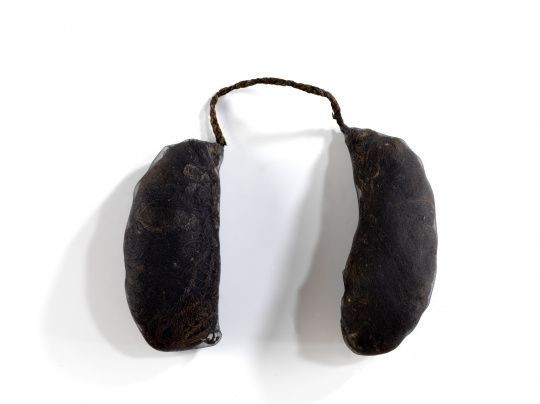
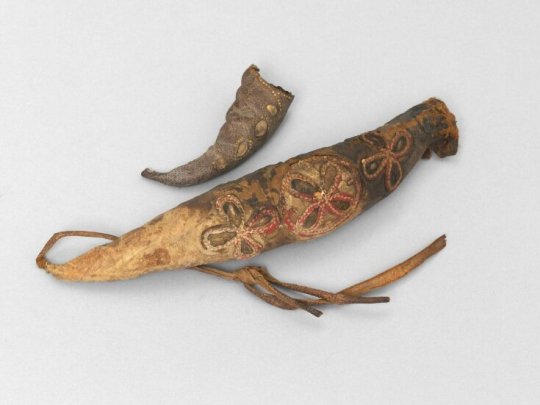

The first are these padded headpieces. In the past I'd only seen the one made of leather with flowers on it in the V&A, which notes its possible usage. However it was only until recently when I began poking around on the French internet when I found more, and better yet, an undeniable depiction of a woman wearing the headpiece. Before this I'd seen some depictions that may be the headpiece being worn, but usually seem much flatter than these were made to be or like they're a more standard gold diadem.
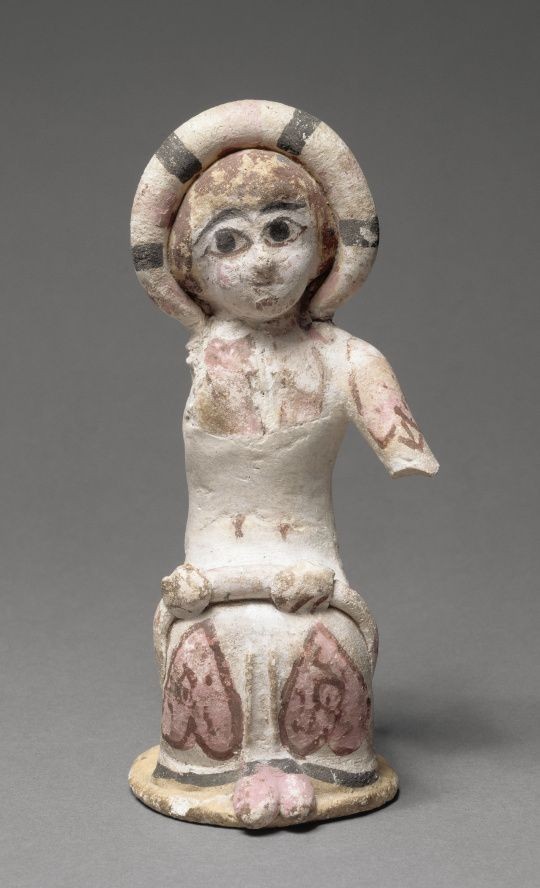
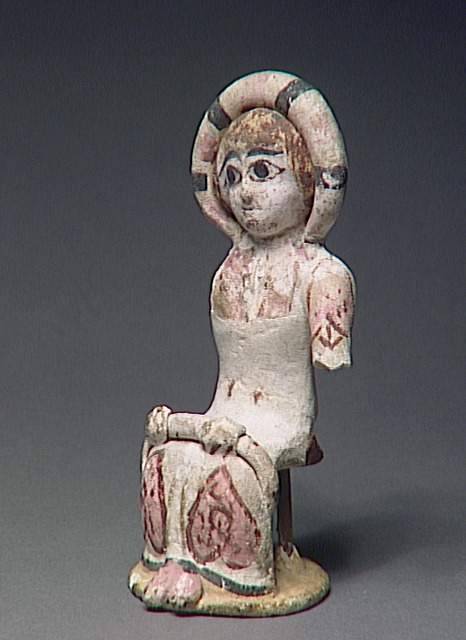
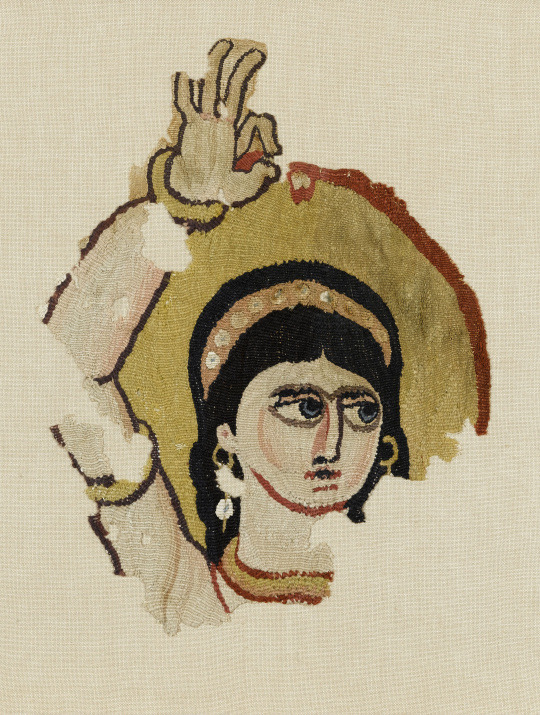
In addition to this, there are a few depictions of Coptic figures wearing these flower bud/petal crowns (more popular in the earlier part of Roman Egyptian art history), which makes me wonder if these were ever used as a base for those.


It's also possible this was out under the turbans worn by women in Coptic art. An example of a bust from Byzantine exists of a woman wearing a turban from Constantinople, and when viewed from the side it can be seen that the volume at the front of her headdress terminates in points near the nape of her neck/her ears. However, this bust also lacks the volume one would expect from the examples if a roll like the extant examples was used.
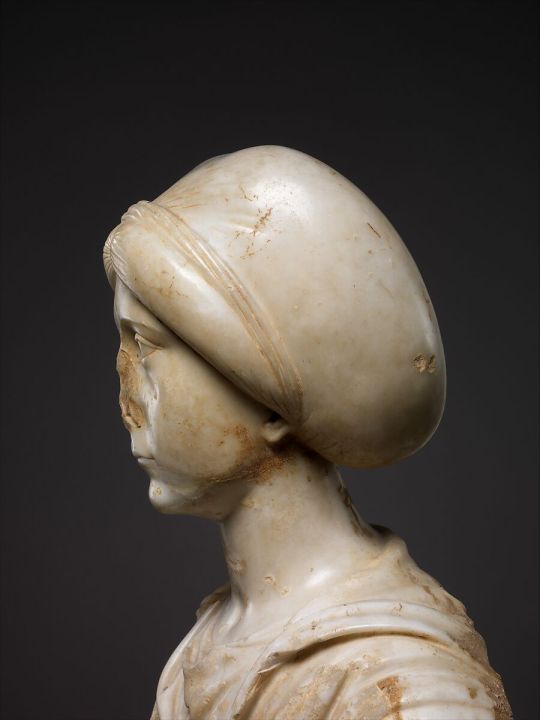
The other piece is one I noticed before, and isn't specific to Egypt, or originated from there. It seems to have come from Palmyra, and is fairly common in the funeral busts we have from there.

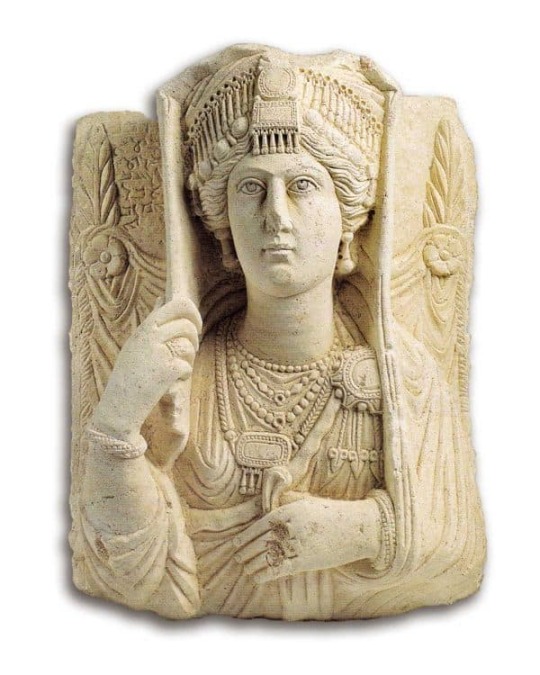
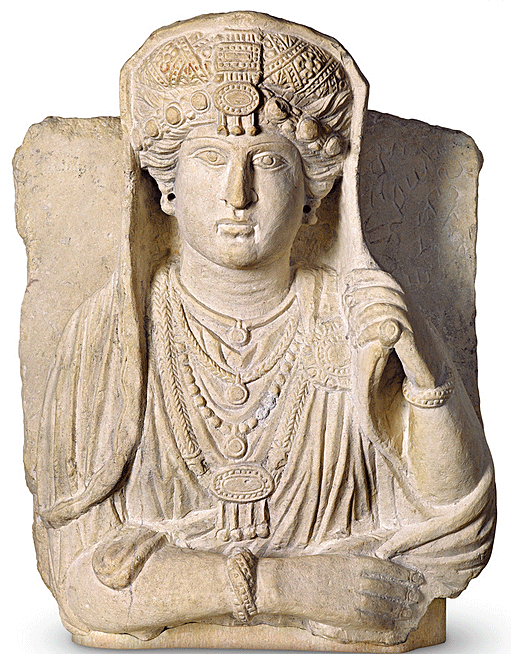
These are small plaques of metal and gems, typically with a few small beads dangling over the forehead. Currently it's supposed that they were attached to a woman's bun in some way.

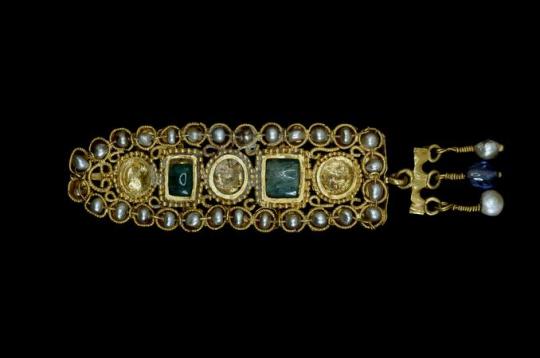
Here's a Roman-era Greek bust and a Roman- era Tunisian example.
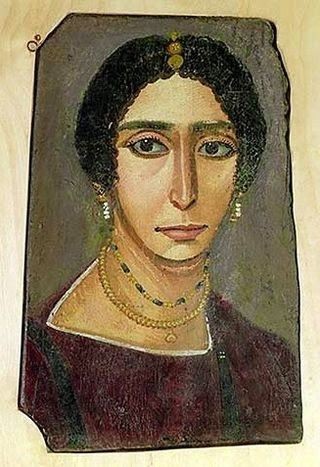
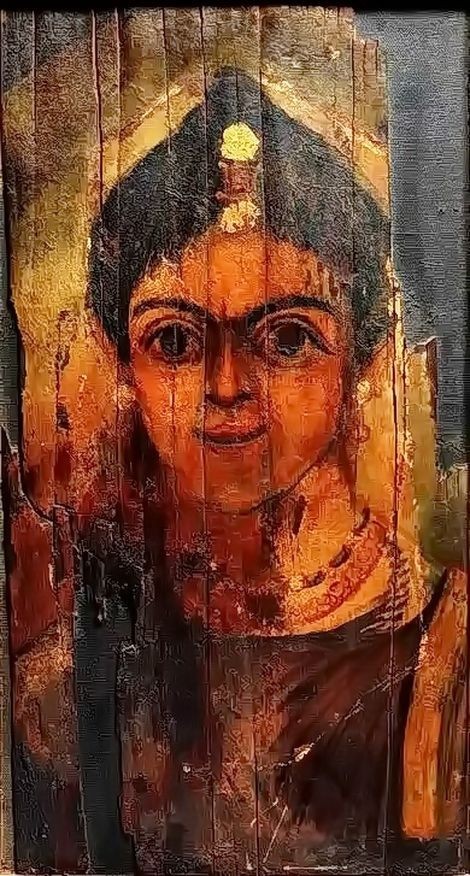



Heres some Roman-Egyptian portraits with similar head jewelry. So far, I haven't found a definitive later Coptic depiction of one being worn, but I don't think that means they stopped being worn before Christianization. It's possibly just a matter of what art has survived and what I've personally seen. Generally, Coptic jewelry is similar to the jewelry from earlier Roman-Egyptian examples, with some more unique examples and examples that were inspired by later trends in the Byzantine Empire.

One of the possible Coptic examples is from the tomb of Theodosea (full disclosure: Theodosea herself was Greek Christian living Egypt, not a Copt in the sense we mean it now, but she's dressed in a way generally common in Egypt at the time. I use "possible Coptic example" here to indicate the contemporary cultural majority of Egypt, which is distinct from the pre-Christian cultural identity of native Egyptians). Theodosea here is identified by Engy Hanna as wearing some type of golden hairnet, with a green pendant with 3 hanging pearls and two strings of hanging beads attached. Because of her palla, it's impossible to tell if she has only one medallion attached to her hairnet or if this is a strip. The overall composition of elements (a cover over the hair, the two strands, center ornament, and a shawl over top the head) are very similar to Palmyran headdresses, though she doesn't wear a turban or the patterned fillet they do.


Recently, I found a bust on an auction site labeled "Roman, probably made in Egypt" from the 1st century, with this ornament but made of a more pliable material- probably fabric. And another on the same site, maybe Egyptian (the information mentions both the terms Gandhara and Greco-Egyptian), with the more typical jeweled look, 2nd-3rd century (which is more into the swing of Christianization in Egypt).



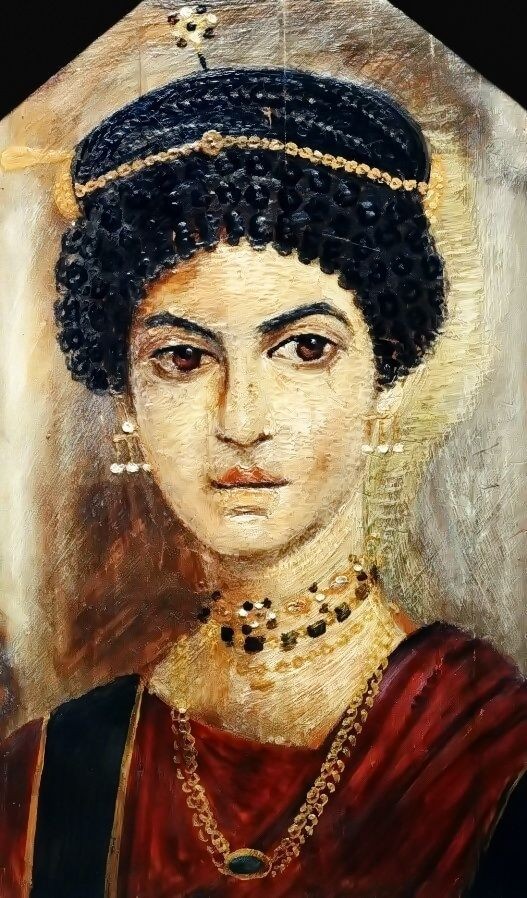

The last aside is another jewelry piece resembling that of Palmyra, though less so: a kind of circlet that appears to be made of chain with a center pendant. The star pendant worn by the second woman also notably resembles the pin holding the strip to the Greek girl's updo. The hanging strands of Theodosea are more blatant, but it's possible these were elaboration on the fashion. This style of jeweled forehead circlet, unlike the headband and strip (I have seen art of Syrian and Egyptian women with a strip, as well as Nubian art of women with a fillet/circlet and a center strip. The latter seems to be a more widely used item than the former two, which I have only seen one depiction each of so far), has remained consistently popular in West Asia and North Africa. Additionally the padded band worn by one of the Palmyran women featured here could be a related item to the padded headband; to know one would have to see the back of her head or find an artifact connecting the two. Even if a relationship can be proven between the Byzantine, Palmyran, and Coptic padded fillets, there is no clear indication of where it originated.
*I am a Copt, and if you are not, do not tag this post talking about "recreations". I find that offensive given the actions taken by Albert Gayet in regard to the clothes he took from graves. It is a simple boundary and you will not "enlighten" me to see how it's fine.*
Sources/Further reading:
https://art.rmngp.fr/fr/library/artworks/femme-assise_terre-cuite_polychromie-technique
https://art.rmngp.fr/fr/library/artworks/bourrelet-de-coiffure-postiches_laine-textile
https://art.rmngp.fr/fr/library/artworks/bourrelet-de-manteau_laine-textile
https://art.rmngp.fr/fr/library/artworks/bourrelet-de-mantelet_laine-textile_textile-matiere_lin-fibre | sources for 3 of the padded fillets and the figurine
https://collections.vam.ac.uk/item/O353014/pair-of-fillets-unknown/
https://www.metmuseum.org/art/collection/search/468716 | the marble bust
https://www.persee.fr/doc/bch_0007-4217_1969_num_93_2_4903 | in German, has photos of carvings with the hair ornament
https://www.sothebys.com/en/auctions/ecatalogue/2016/ancient-marbles-classical-sculpture-art-l16260/lot.59.html | carving of the short haired child
https://www.sothebys.com/en/buy/auction/2022/ancient-sculpture-and-works-of-art/a-roman-marble-portrait-head-of-a-girl-circa-2nd | carving of a girl with a jeweled strip, may be Egypt as the notes say an image of it was published in a work on Greco-Egyptian art and the girl has an "Isis lock" hairstyle
https://www.jstor.org/stable/4241695 | overview of Palmyran jewelry
https://www.britishmuseum.org/collection/object/G_1903-0717-3 | Tunisian example of strip
https://www.livius.org/pictures/greece/thessaloniki/thessaloniki-museum-pieces/thessaloniki-portrait-of-a-girl/
https://womenofegyptmag.com/2020/02/11/what-coptic-artefacts-tell-us-about-women-in-ancient-egypt-part-one/
#Coptic art#Coptic culture#Late Antiquity#Late Antique Egypt#Masr#Copt#Actually Egyptian tag#Cipher talk
90 notes
·
View notes
Text

Statue (dolomitic limestone) of a Ptolemaic queen bearing a "Cleopatra" cartouche, perhaps representing Cleopatra VII (r. 51-30 BCE). Now in the Metropolitan Museum of Art.
#classics#tagamemnon#ancient history#Hellenistic period#Egypt#Ancient Egypt#Ptolemaic Egypt#Hellenistic Egypt#Cleopatra#Cleopatra VII#art#art history#ancient art#Egyptian art#Ancient Egyptian art#Hellenistic art#Greco-Egyptian art#Ptolemaic art#sculpture#portrait sculpture#statue#limestone#stonework#carving#cartouche#Metropolitan Museum of Art
168 notes
·
View notes
Text
Seasonal theme: Magical summer (beginning)
This summer will be a season of wonders and enchantments, of spells and wizards - a magical summer!
Here is a list of beings, entities, objects and concepts you can check out if you want to add some magic to your summer:
In the myths, legends and so-called “real” world...
In the Arthurian literature: Merlin the enchanter, most famous of all wizards, derived from the legendary Welsh figure of Myrddin. Morgan le Fay, the ever-so-ambiguous enchantress of Arthurian mythos. Excalibur, the greatest and most iconic of all magical swords.
In Greek mythology: Hecate, the goddess of magic and witches. Circe, the divine enchantress of the Odyssey. Medea, the most frightening sorceress of the Greek legends. Lamia, a Greco-Roman bogeywoman that medieval times assimilated with various monsters and witches.
In Norse mythology: seidr, the old Norse magic, and its patron goddess Freya. Loki, expert shapeshifter and trickster supreme.
Christian legends, myths and beliefs: the Malleus Maleficarum, the unfamous manual used by many witch-hunters during the great witch hunts throughout Europe - a manual which was not accepted by the Church, unlike what many people believe. The Ars Goetia, both the art of invoking demons and the grimoire containing the secrets of said art. Astaroth, a demon often associated today with witchcraft. The famous witches sabbath, that was the great terror and fantasy of devil-fearing men of the Middle-Ages and the Renaissance. The paintings of Goya, which illustrated the various superstitions and beliefs surrounding witches in Spain.
The folklore of the British Isles: the British Grimalkin, with its cousins the English King of Cats and the Celtic Cat-sith. Lugh, the Irish Celtic god that mastered all of the arts, including magic.
Vaïnämöinen, the great bard-enchanter of Finland, and one of the sorcerer-heroes of the Kalevala alongside the magical blacksmith Ilmarinen, all fighting against the evil witch-queen Louhi.
In fairytales: the fairytales of the brothers Grimm brought many of the famous fairytale witches, from the evil queen with her magic mirror in Snow-White to the witch living in a house of bread and sugar in Hansel and Gretel. In Slavic fairytales, the great and iconic witch is the dreaded Baba Yaga. The French fairytales also brought the archetype of the fairy godmother: Cinderella, Toads and Diamonds, Donkeyskin, Cunning Cinders, The Hind in the Woods/The White Doe, Prince Marcassin... And let’s not forget Carabosse, the wicked fairy of the fairytale Princess Mayblossom, that became thanks to Tchaïkovsky’s ballet the old antagonistic fairy of Sleeping Beauty. Plus: the seven-league boots, one of the most famous magical items of French fairytales, appearing in Little Thumbling or The Orange Tree and the Bee.
The world of alchemy: the famous philosopher’s stone, elixir of life, and panacea that formed the ultimate goals of alchemists. Hermes Trismegistus, the mythological patron and ancestor of all alchemists (himself a mix of the Greek god Hermes and the Egyptian god Thoth). Nicolas Flamel, the 14th century book-seller everybody believed to be the discovered of the philosopher’s stone.
Some famous grimoires of our world: The Book of Abramelin, a tome of sacred Jewish magic. The Lesser Key of Solomon, a demonology grimoire of the 17th century inspired by the older book of sacred spells known as The Key of Solomon. The very famous duo of French grimoires known as the Grand Albert and Petit Albert. The Book of Shadows, a type of grimoire originally part of the Wicca religion, and that became popularized in America media thanks to the television series Charmed.
Principles, beliefs, personalities and practices of our world (which, as you will note, frequently mix magic with religion and folk-healing): Nostradamus, the great French prophet. The magi of Persia, Zoroastrian priests and astronomers that gave birth to the concept of the “mage” as we know it today. The original mana - not the video game mechanic, but the supernatural force of Oceanian beliefs. The Celtic druids and the most famous of their sacred sites: Stonehenge. The marabout, a type of Muslim holy man from Africa to whom was attributed some magical powers in folk-belief. The shamans of Siberia, the ones from which the very principle of “shamanism” was codified in the West. The medecine people of the First Nations in Northern America. The sangomas of Southern Africa, one of the most famous types of African “witch-doctors”. The Haitian Vodou and the Louisiana/New-Orleans Voodoo, folk-religions and magic beliefs deriving from the Vodun religion of West Africa (not to be confused with their various “cousins”, such as the Vodu of Cuba, the Jejé of Brazil or the Hoodoo).
More general magic tropes and concepts: the magic potion. The flying broomstick. The magic wand, or its variation the wizard’s staff. The familiar of the witch. The trope of the wizard duel, which, despite its prominence in modern literature and contemporary folk songs, has roots in ancient mythological fights and legendary magic hunts. The tempestarii, or the belief in weather-influencing, weather-changing sorcerers.
#seasonal theme#magical summer#magic#witches#wizards#sorcerers#mythologies#greek mythology#norse mythology#celtic mythology#witchcraft#arthurian mythos#arthuriana#grimoire#demonology#finnish mythology#fairytales#fairy tales#fairies#alchemy#folk medecine#folk religion#tropes#archetypes
38 notes
·
View notes
Text
I had this headcanon of what if the Clones in Clone High can actually speak to their Clone parents via a spiritual convo gadget ( cuz why not )
Here are some of my HCs of how some of their Clone parents be like with their Clone kids :
. Look, considering the fact that their Clone parents lived in different times as them, those clones are bound to have some wild advice
. Vincent Van Gogh be a gentle and artistic parent who tries his best to help his Clone son battle through depression. It breaks his heart seeing his Clone son having depression as he does, so one way for him to try help his Clone son is through art therapy ( it works, most of the time )
. Julius Caesar be kinda like that military, athletic dad who has high hopes in his Clone son and trains him in military and politics related shit. But if he comes to Caesar and cries to him about heartbreak and stuff, ofc Caesar is gonna lend him a shoulder to cry on ( after all, Romans are encouraged to embrace their emotions growing up ).....while having murder on his mind
. Cleopatra VII be that glam mom whom Cleo Smith looks up highly too but sometimes wonders how tf she can live up to her Clone mom's big name. And sometimes, Cleopatra sometimes tries to help her Clone daughter compose herself more ( I bet Julius Caesar and Mark Antony prepared her for her Clone daughter )
. In fact, sometime after Clone High began, Caesar and Cleopatra are reunited through a series of trials and such in afterlife planes ( cuz Cleopatra avoided him all these years due to her thinking that he doesn't love her anymore regarding the whole Actium War thing, the Egyptian Gods are at cold war situation with the Greco Roman gods for centuries since the Actium War until sometime after WW2 and such ) and the two basically agreed to co parent each other's Clone kids. Bless
. Abraham Lincoln is kind of like an ' old school ' type of dad to Abe who loves his Clone son and wants the best for Abe. He also tries his best to encourage Abe to develop more of a backbone and stand up to ' big headed machos ' from being pushed around ( by JFK Jr and Julius Jr before they eventually sincerely apologized )
. Genghis Khan be kinda like that scary dude in PTA meetings but actually doting and caring to his Clone son and wanted the best for him. He keeps saying that his Clone is his 366th child ( I heard Genghis Khan ended up having 365 Kids and 1001 grandkids- DAMN )and trains Genghis Jr in fitness, politics and such
. Joan of Arc be a cool lesbian mom who supports her Clone daughter's dreams and sexual orientation, and ofc gives her Clone daughter sound advice. Joan of Arc knew from the get go that Abe doesn't deserve Joan Jr ( HAAAAA!!!! )
. Confucious be kinda like Master Oogway and/or Shifu to his Clone son's Po - trains him in philosophy, defense combat and such And gives his Clone son sound advice
. Frida Kahlo be like a wacky cool mom to her Clone daughter, encouraging her Clone daughter's artistic passions and talents and the two be regularly exchanging artistic ideas with each other. Bless.
. Harriet Tubman be giving her Clone daughter tips on how to fight racist thugs ( YASSS!!!! ) and also encourages her Clone daughter's dreams and hopes and gives her Clone daughter some solid advice.
. JFK be kinda like a 50s/60s athletic dad to his Clone son, encouraging his athletic and political prowesses and such. JFK sometimes find himself having to ensure his Clone son doesn't do anything TOO stupid tho.
. Sacagawea be that ' cool ' mom to her Clone daughter who teaches her Clone daughter about embracing her heritage and geography and such, ofc she gives her Clone daughter several sound advices too
. Some of the clones have some DNA from those with close relations to their Clone parents
. Julius Jr got some DNA from Caesarion and therefore has recessive DNA from Cleopatra VII. JFK Jr got some DNA from John John Kennedy and therefore has recessive DNA from Jackie Bouvier. Cleo Smith got some DNA from Cleopatra Selene II, and Abe got some DNA from Mary Todd Lincoln
. Genghis Jr got some DNA from Empress Borte ( Genghis Khan's chief wife )
. Several clones of rulers be bonding over how tough it can be to bear the weighs of their ancestry on their shoulders
#clone high#clone parents#clone high hcs#joan of arc#jfk#julius caesar#cleopatra vii#confucious#frida kahlo#harriet tubman#abraham lincoln#jackie bouvier#mary todd lincoln
40 notes
·
View notes
Text

Plate with Sphinx from the Greek colony and emporion of Naucratis in Egypt. 6th century BCE. Herodotus was the first author who described in his Histories the creation and development of Naucratis under the Pharaohs of the Saite dynasty.
Source: https://www.francetvinfo.fr/monde/naucratis-cite-antique-redecouverte-dans-le-delta-du-nil_1717439.html
5 notes
·
View notes
Note
Hi! May I ask which are some good super starter or basic grimoires? I tried Agrippa and just...it didn't go in...i have the Picatrix but I honestly think I'll just get the same result, it's way above my head. Is there anything simple i might "get" or should I honestly just accept it's not for me and move on? Thank you!
Hey, so I have this post right here that goes over why no grimoire that's worth learning from with the intent to practice it through is going to be classified as beginner/starter/etc. So I'm not going to rehash that part.
As for "getting" Agrippa, I think it's important to remember that it's an encyclopedia. As such, when you're beginning to explore grimoires, it's best to use it as a reference book. Can you use Agrippa as the foundation of your own practice? Yes, but unless you're already familiar with occult concepts and topics, it might require far more than one or two surface readings to fully digest what it's talking about.
So since it sounds like you're newer to grimtrad circles, I have a few books that I think might help build that foundation without all the dense walls of text and jargon to read through (though please bear in mind that I struggle to remember what is/not common knowledge even in mundane matters, so if some of these are a bit trickier to navigate, feel free to blame it on my incompetence):
A Deed Without A Name by Lee Morgan (staple)
Conjuring Spirits by Miller (Miller's work is v good)
The Black Arts by Richard Cavendish (read critically, don't accept everything blindly)
The Hermetic & Alchemical Writings of Paracelsus - Waite & Paracelsus (denser)
Magic, Witchcraft, and Ghosts in Greek and Roman Worlds
Elucidation of Necromancy
Celestial Intelligences by Kaminsky (denser)
Wortkunning
Some books that I worked with or through that seem easy enough to bring to real life application, with the right dedication and mindset:
The 6th & 7th Books of Moses
The Sworn Book of Honorius
The Book of Oberon
Seven Spheres & Gateways: Through Stone and Circle (1 book) & Through Light and Shadow (different book) - best combo, anyone can practice these really
Keys of Solomon & Grimorium Verum & Secrets of Solomon - solid combo
The Goetia of Dr. Rudd (a particular fave)
The Complete Mystical Records of Dr. John Dee (learn a bit of Latin first or have a solid translator on deck)
Greek Magical Papyri (PGM) & Greek and Egyptian Magical Formularies & Techniques of Greco-Egyptian Magic - best combo, imo
Orphic Hymns Grimoire & The Hekatæon & Tartaros - another good combo
The 32 Keys
Azoëtia & The Black Dragon series
Book of St. Cyprian
I think it's worth mentioning that reading more is a great way to broaden your awareness of occult concepts and topics. If you look at how things are considered across different dedicated areas of study, then you're more likely to understand the foundations of said thing. One perspective is very limiting. It's better to seek out multiple. By reading from the first list, which should give a pretty solid introductory to broad concepts, and then sifting through the grimoires mentioned, you should be able - through applying yourself properly to the task - gain an understanding of how these things may function/interact in a living tradition, and then through applying them yourself gain the practical knowledge of how they actually are.
And as a closing note: I would personally recommend leaving behind the idea that you're supposed to "get" occult books. You study from them, you learn what you can from them, and through implementing what they speak of and experimenting with what interests you, you acquire that knowledge plus your own discovered knowledge and heightened awareness. In this way, you'll come to realize why I refer to my engagement with the occult as a study and practice.
Of course, if none of this was helpful, you can feel free to disregard my input here as the ramblings of a twenty-something nobody. Have a good one!
35 notes
·
View notes